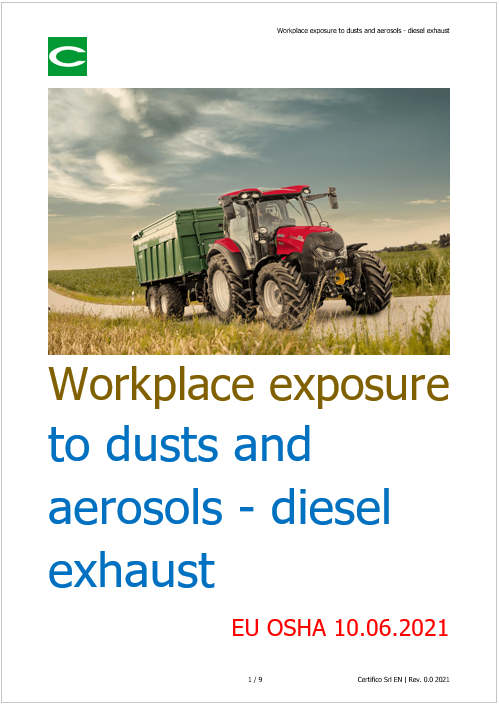
Workplace exposure to dusts and aerosols - diesel exhaust
ID 13791 | 14.06.2021
EU OSHA 10.06.2021 Workplace exposure to dusts and aerosols - diesel exhaust
Diesel engines are widely used for transport and power-supply and, therefore, occupational exposure to diesel exhaust is common.
In 2012, the International Agency for Research on Cancer (IARC) classified diesel exhaust as carcinogenic to humans, mainly based on the increased lung cancer risk observed in epidemiological studies.
In recent years, tightened emission regulations in the EU and other parts of the world have caused a significant evolution of diesel technologies, resulting in a change in the emission and composition of the exhaust.
Introduction
Diesel engines are widely used for transport and power-supply and, therefore, occupational exposure to diesel exhaust is common. In 2012, the International Agency for Research on Cancer (IARC) classified diesel exhaust as carcinogenic to humans, mainly based on the increased lung cancer risk observed in epidemiological studies. In recent years, tightened emission regulations in the EU and other parts of the world have caused a significant evolution of diesel technologies, resulting in a change in the emission and composition of the exhaust. The present article reviews the health effects of diesel exhaust, exposure at workplaces and the means available to reduce the exposure.
Composition of diesel exhaust
Diesel exhaust is a complex mixture of gaseous and particulate components produced in the combustion of diesel fuels. The emission rate and composition of the exhaust depend, for example, on the type, operational condition and maintenance of the engine, on the composition and properties of the fuel, and on the exhaust after-treatment techniques in use. The main gaseous components of diesel exhaust are carbon dioxide, oxygen, nitrogen, water vapour, nitrogen oxides and carbon monoxide. In addition, sulphur dioxide and various organic compounds, such as low-molecular-weight carbonyls, carboxylic acids, alkanes, alkenes and aromatics may be emitted in the gas phase.
In addition to the gases and vapours, diesel exhaust contains tiny particles which are formed in the combustion process and in the subsequent condensation of gas phase compounds. These particles are composed of elemental carbon, adsorbed organic compounds, sulphates, nitrates and trace amounts of other elements[1]. Diesel exhaust particles are respirable; approximately 90% of the particle mass exists in the fine size range (≤2.5 µm). Nanoscale particles (≤50 nm) make up to 90% of the particle number concentration. Due to their small size, the particles may reach the pulmonary alveoli, the sensitive gas-exchange region of the lungs.
It has been reported that the use of biodiesel instead or as a blend with a fossil fuel may moderately reduce the emissions of particles, total hydrocarbons and carbon monoxide but at the same time, the emission of nitrogen oxides often increases[4]. In general, the biodiesel-derived exhaust gases contain less of genotoxic polycyclic aromatic hydrocarbons but more of irritative aldehydes and ketones.
[...]
Health effects
Respiratory and cardiovascular effects
Exposure to diesel exhaust may evoke irritation of eyes, nose and throat and the experience of unpleasant smells. A mild airway inflammatory response and increased airway resistance has been detected in volunteers exposed to relatively high levels of diesel exhaust (particles: 100–350 µg/m3; NO2: 0.2–1.6 ppm) for 1–2 hours (see and references therein). In addition to the respiratory effects, indications on cardiovascular effects, such as changes in the function of blood vessels, have been observed in the studies[10] [11]. Furthermore, epidemiological studies have associated ambient air pollution, especially particulate matter, with acute cardiac effects and development of chronic cardiovascular diseases. However, the underlying mechanisms and relative importance of the different constituents of diesel exhaust to the observed effects are not fully understood.
In animal studies, exposure to diesel exhaust has been associated with increased response to allergens and decreased viral and bacterial clearance from the lungs[9]. In rats, long-term exposure to high levels of diesel exhaust has triggered inflammatory and histological changes in the lungs[1]. At very high exposure levels, lung tumours have also been detected.
Carcinogenicity of diesel exhaust
In June 2012, the International Agency for Research on Cancer (IARC) updated its evaluation on the carcinogenicity of diesel exhaust and re-classified diesel exhaust as carcinogenic to humans (Group 1). The update was mainly based on the recently published epidemiological studies on lung cancer risk related to diesel exhaust exposure among non-metal miners, railroad workers and workers in the trucking industry. Most notably, a large study among the US non-metal miners has showed an increased lung cancer risk with increasing exposure to diesel exhaust. The lung cancer risk among the workers with the highest exposure was nearly threefold in comparison with the lowest exposure group. Miners, especialy underground workers, are exposed to diesel exhausted during activities such as ore extraction, haulage, maintenance, and the use of vehicles. The extensive use of diesel-powered equipment in underground mines and the fact that underground work increases the possibility for exhaust to accumulate, makes it challenging to control workers’ exposure.
There is also limited epidemiological evidence linking diesel exhaust exposure with increased incidence of bladder cancer. Since diesel exhaust is genotoxic to bacteria and mammalian cells, the IARC has concluded that diesel exhaust is likely to induce cancer through genotoxicity.
... Segue in allegato
Fonte: EU OSHA
Collegati
Allegati
|
Descrizione |
Lingua |
Dimensioni |
Downloads |
 |
Abbonati Sicurezza Lavoro
|
EN |
564 kB |
11 |


































